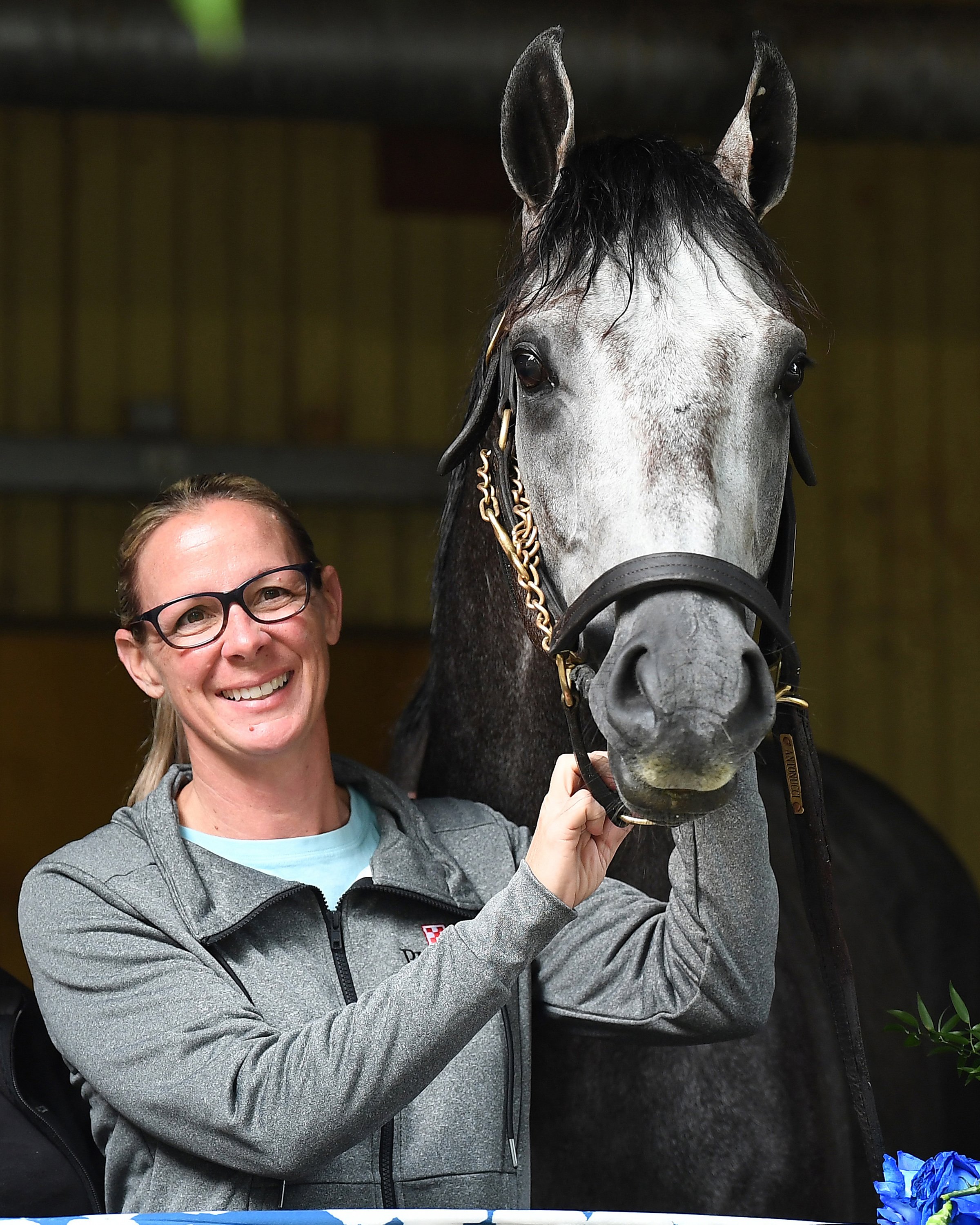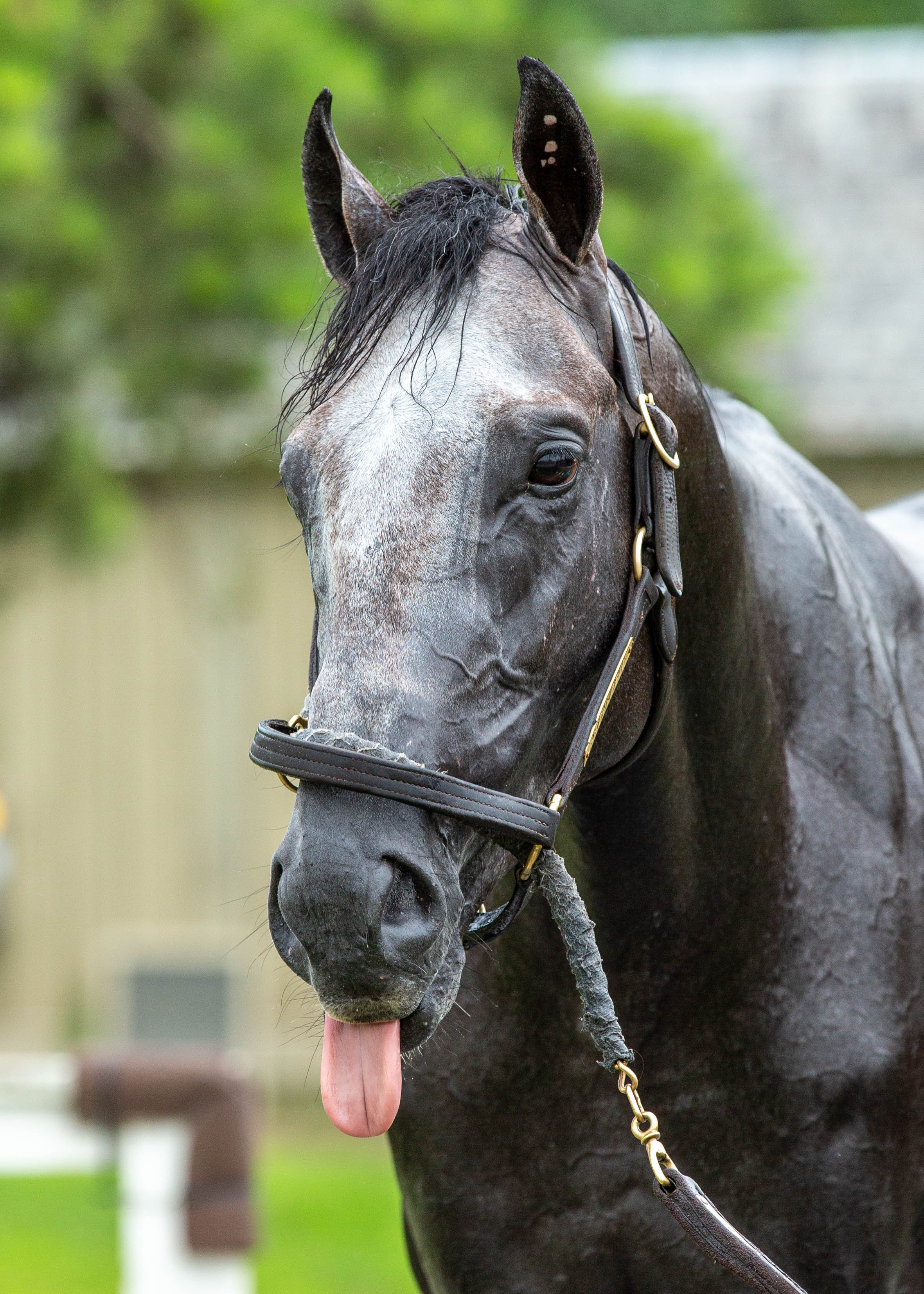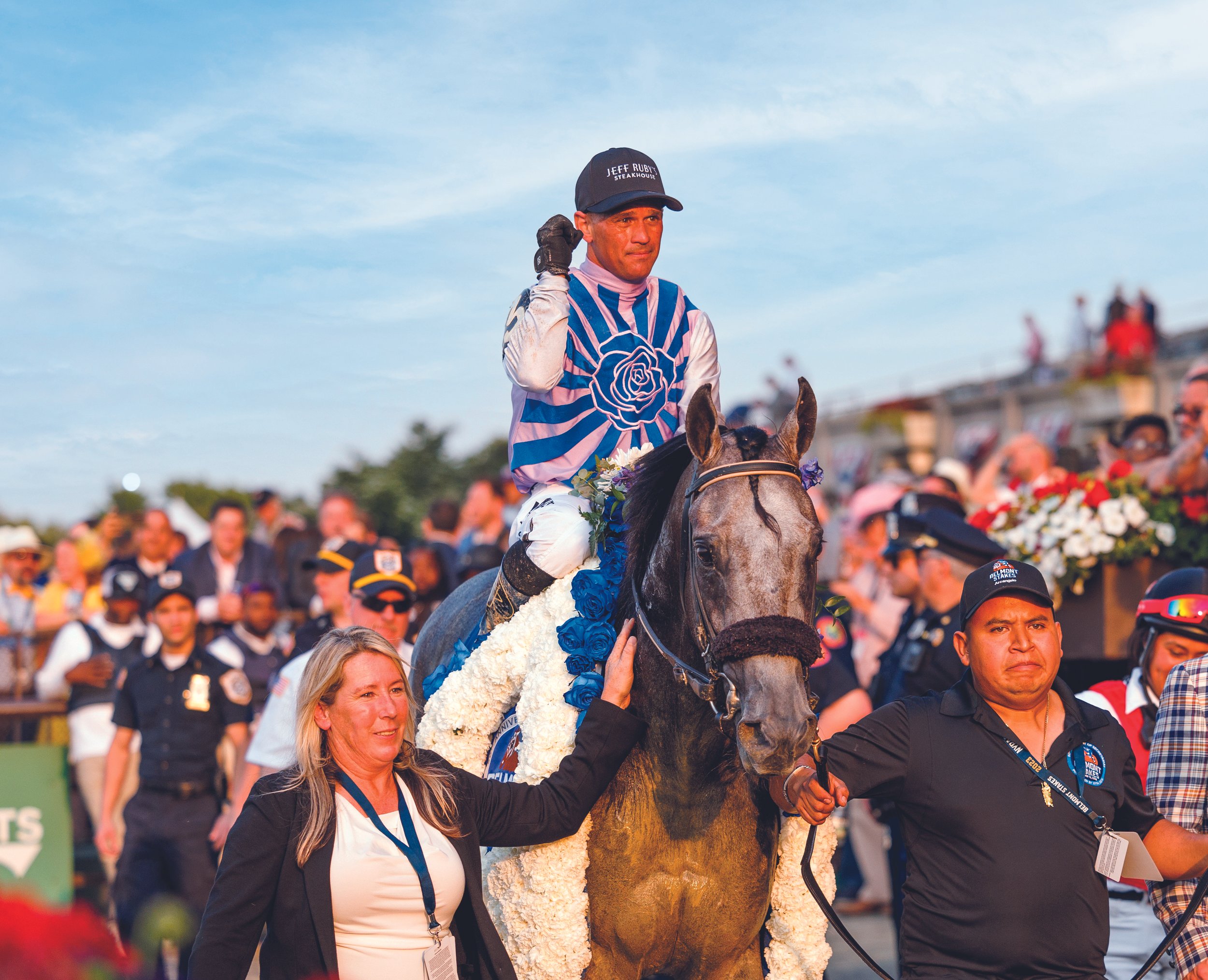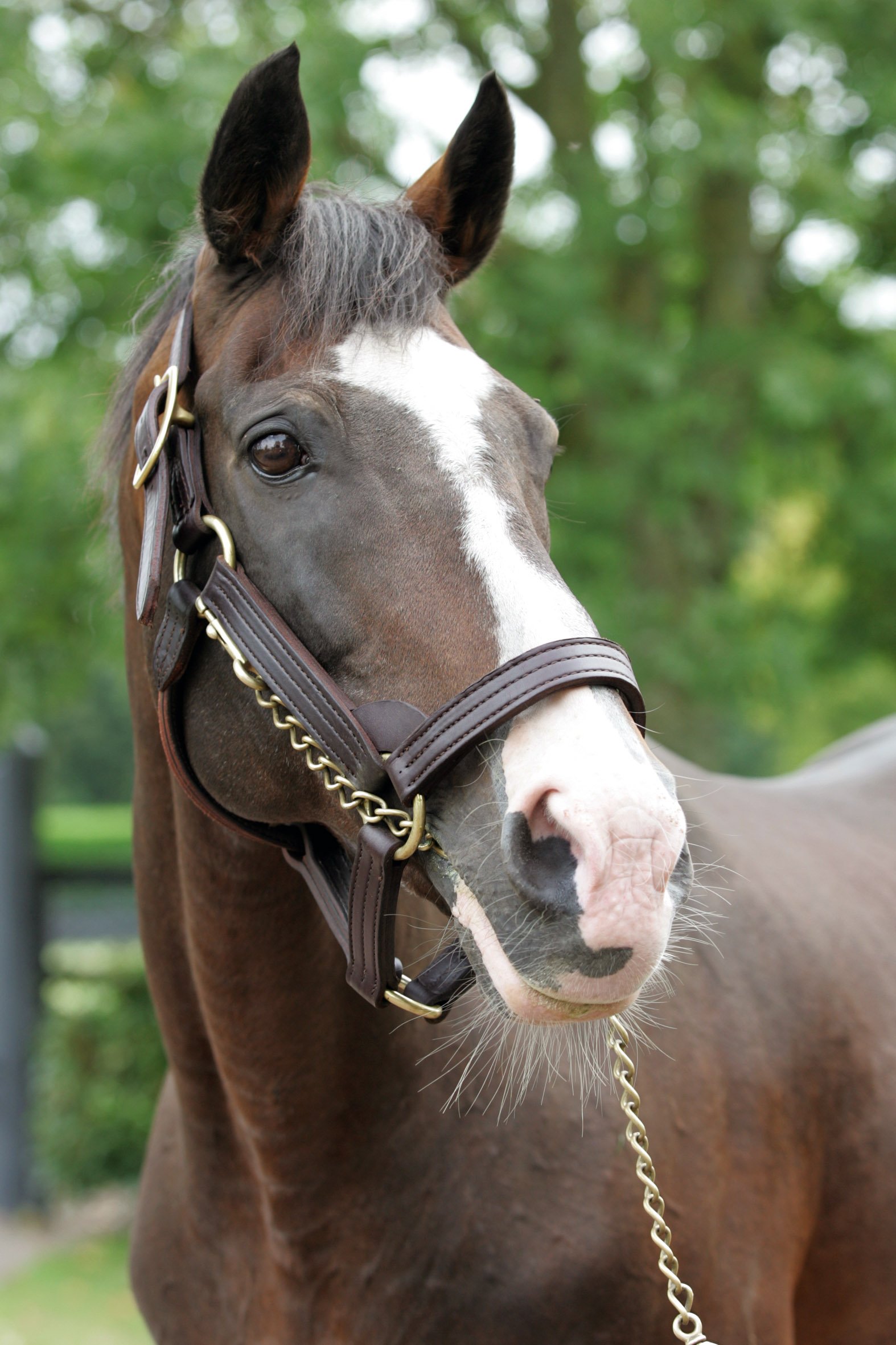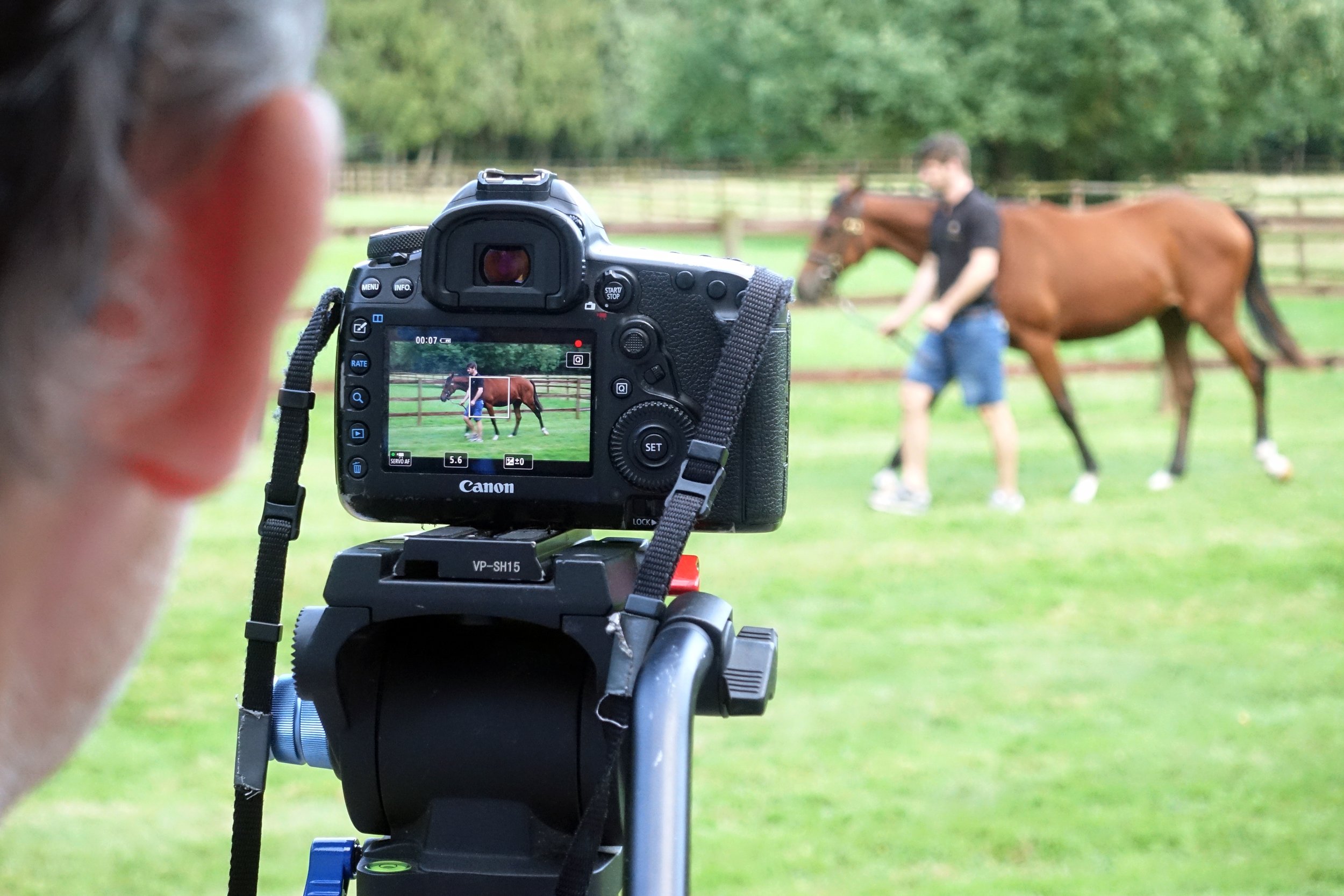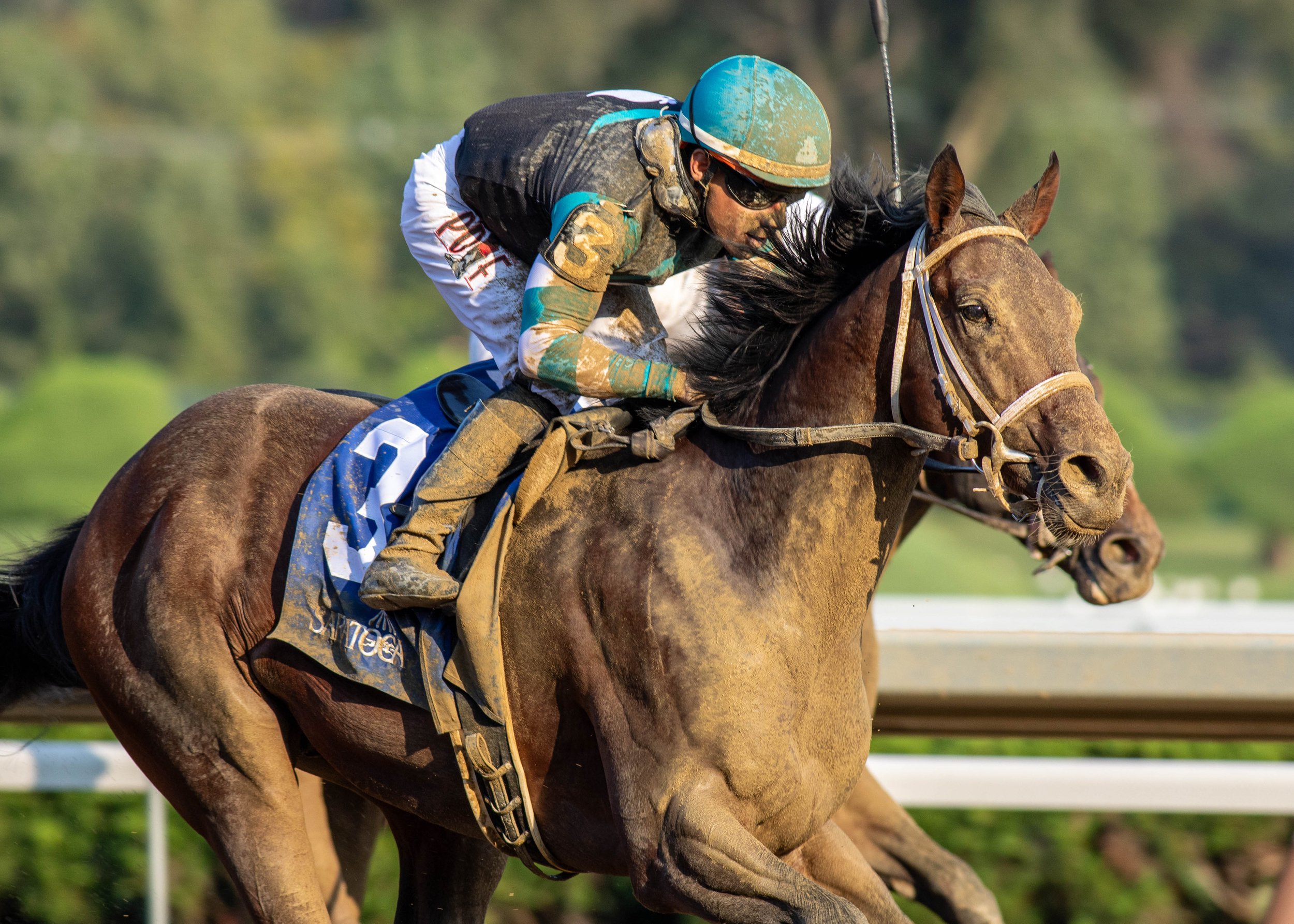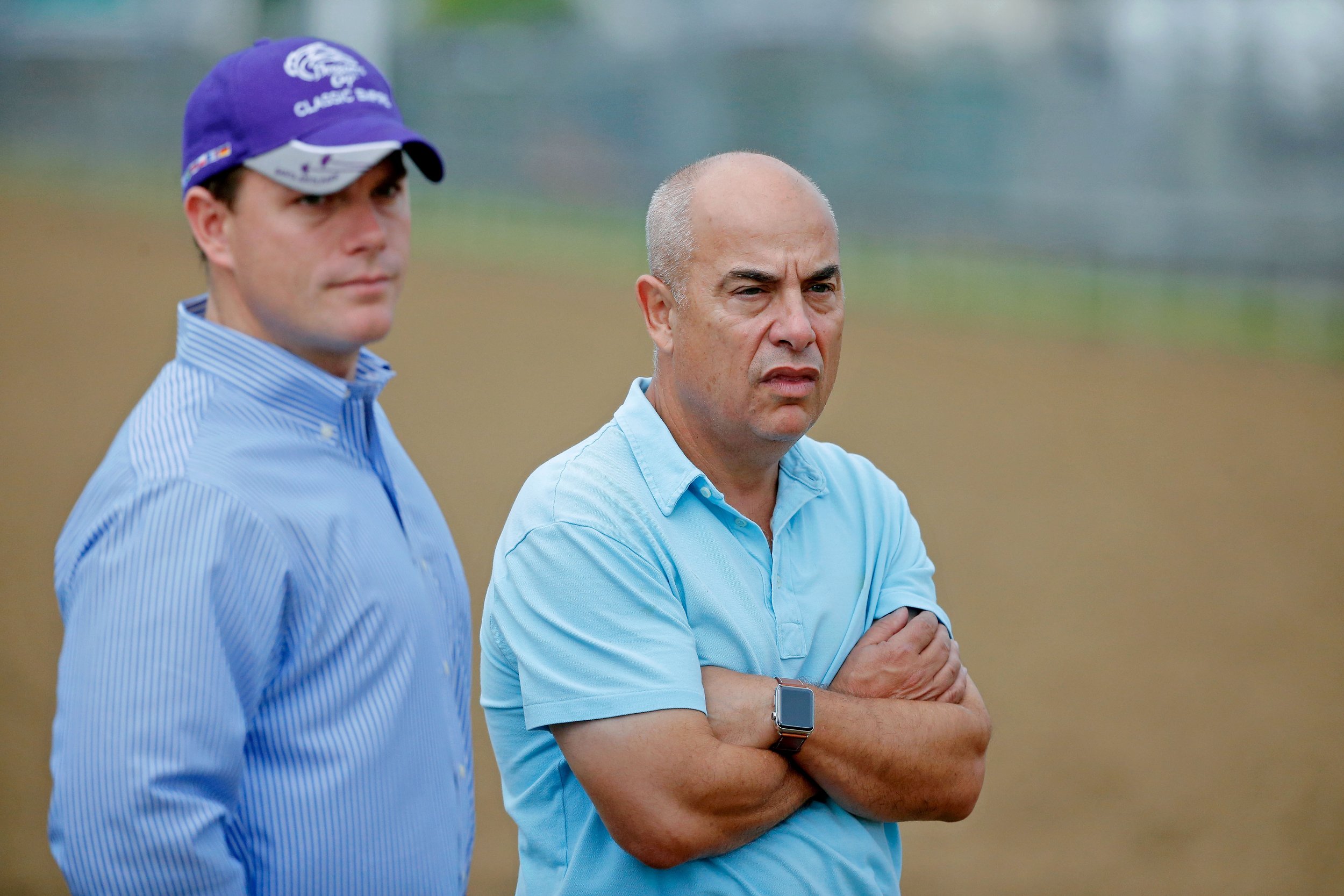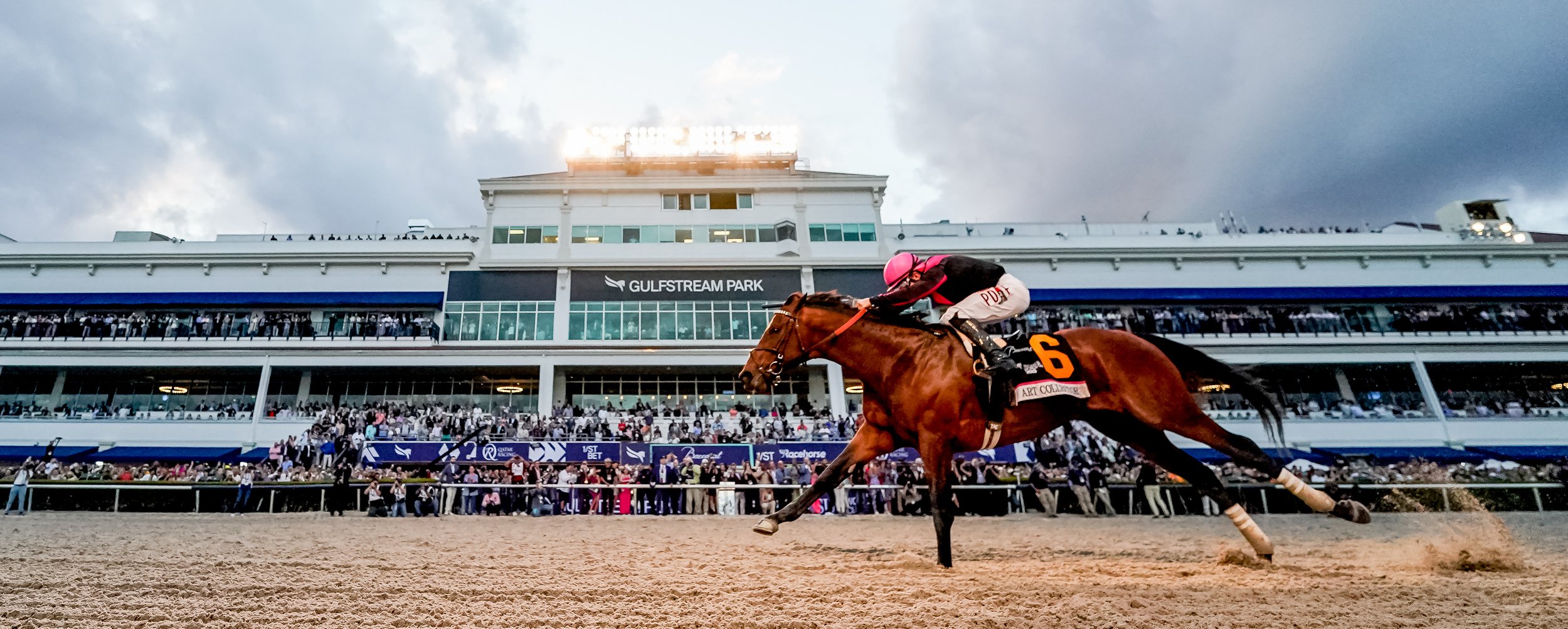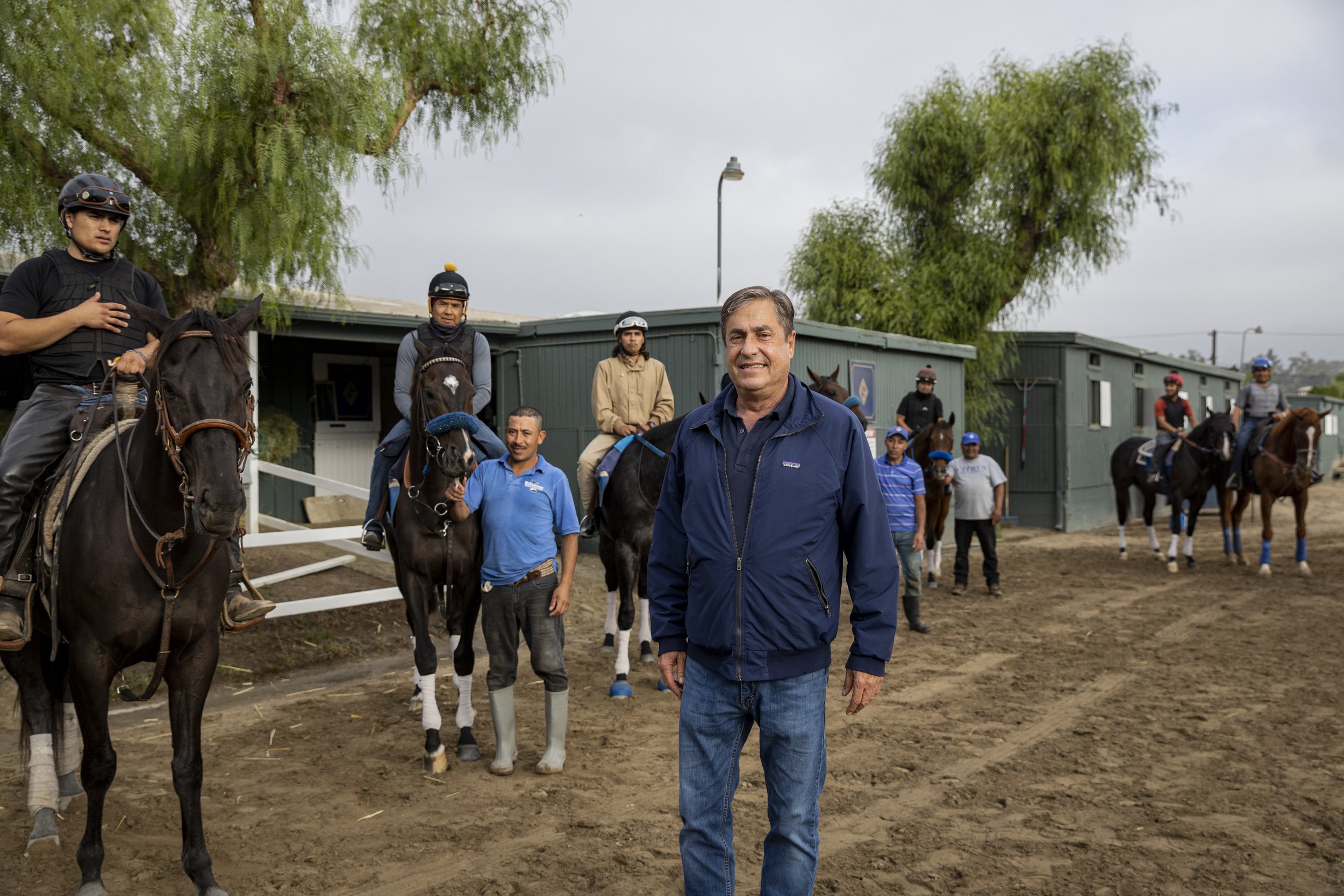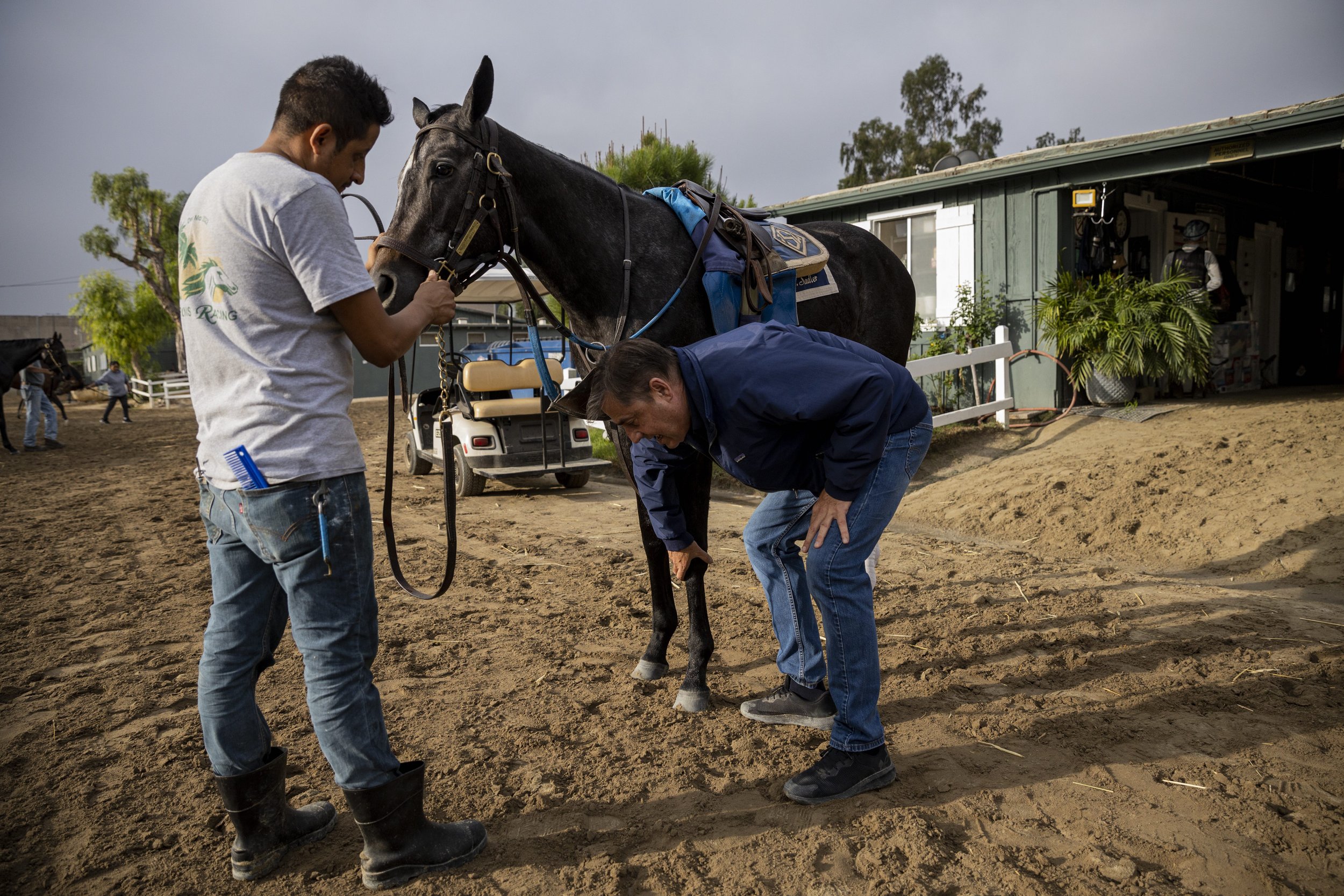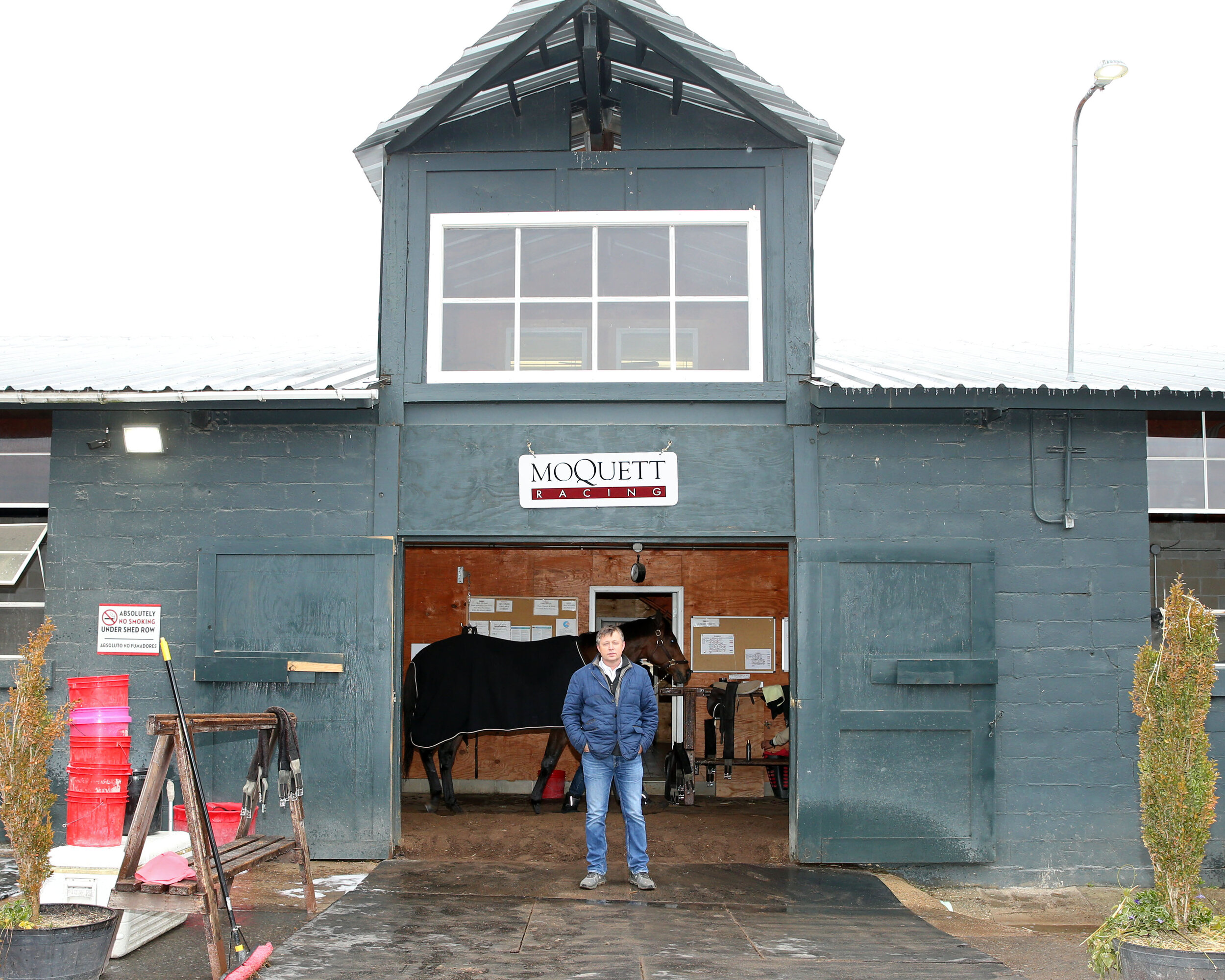Jena Antonucci - trainer of the star 3yo of 2023 - Arcangelo
Words - Ken Snyder
In the media avalanche surrounding Jena Antonucci, after her summer to remember, there is both rich irony and something very telling in one of the three “things you didn’t know” about her that escaped attention: she competed in shotgun shooting events. Those close to her who didn’t know this might say, “That figures,” or “I’m not surprised.” Shooting takes focus and concentration, both of which are in Antonucci’s DNA.
The next thing they would say is probably “I bet she kicked ass.”
Her parting words in an interview on YouTube the morning of this year’s Belmont? “Let’s go kick some ass.”
She does not fit the mold of a Thoroughbred trainer. If “focus” and “concentration” could be scored and put into some kind of competition, she’d likely kick ass in that too.
The two other “things you didn’t know”: she is in her own words a “very good golfer, but without much time to play.” The third thing? She is hesitant to admit that “she doesn’t drink coffee.”
Mold breaker might be an apt description of Antonucci in her handling of success. The example is her response as a small- to medium-size trainer.
“Our number one goal is always wanting to be in the thirty- to thirty-five range, and that’s where we’re focused on staying,” she said. In a purely commercial sense, that’s saying no' to a flood of potential new business in the wake of Arcangelo’s success.
Were there calls from prospective owners after the Belmont and Travers?
“There have been conversations, but it’s been a ‘onesie, twosie,’ here and there, kind of thing.
“We’re not looking to be a stable of 150 horses. It’s not who we are. It’s not who I am.”
Antonucci is a horsewoman who rode show horses from age three into young adulthood and then gained not just experience but the right experience with Thoroughbreds. Her first foray was breaking and galloping them at Padua Stables in Ocala, Florida, where she now lives. She was then a veterinary assistant for four-and-a-half years, which gave her valuable horse knowledge on the ground. Exercise riding after vet work gave her knowledge up top astride a horse. All-important management experience, a necessary skill in any racing stable, came through her Bella Inizio Farm she opened in Ocala. (“Bella Inizio,” incidentally, translates as “nice start” in English.)
As if that’s not enough, she operates HorseOlogy with co-owner Katie Miranda, a Thoroughbred training and ownership organization that spans raising, training and racing while also offering bloodstock advising, pinhooking, micro-investing and more.
Her start in training was at Tampa Bay Downs in 2010, a year that maybe wasn’t the “nicest.” She won two of eight races and had two second-place finishes. Things began to take off in 2013 with 288 starters and earnings of $1,067,303. This year, of course, Arcangelo has vaulted her into the stratosphere with his $1.7 million in earnings.
“We’ve kind of been the ‘little stable that could’ for a long time,” looking back at her previous ten years of training.
“One thing I’ve always been very proud of is horses who have been claimed off of us or who went to a different barn [and] haven’t gone on to become big flourishing horses. I think a lot of mid-size trainers deserve to be evaluated in that manner, and it’s something I think we fail in the industry to do.”
She has, perhaps, a more realistic take on win percentages for trainers and how she believes they are misinterpreted by not factoring in stable size. Her website even has a section entitled Statistics Aren’t the Only Indicator of Success. “I think you can have somebody at 20 percent if they have 200 horses and can put a million-dollar horse in to get the win.”
Arcangelo broke his maiden third time out at Gulfstream Park and has been undefeated since then. “I think we get stuck in the headlines of ‘Oh, won first out!’ It’s atypical. It is likely that less than a single-digit percentage of the horse population annually wins the first time out. We set owners up for failure.
“I think we do a consistent job across the board. I’ve had to make a lot of chicken soup out of chicken poo; and with that, I think I have the reputation for being a good horsewoman who is thorough and is trying to find the missing piece or what we can to find a horse’s success level.”
The missing piece for Arcangelo was careful parceling of his potential Horse of the Year talent. Antonucci’s racing campaign gave the horse more time between starts than other trainers might have given the son of the late Arrogate.
“I give a lot of credit to John [Ebbert], his owner, for allowing this horse to have space. I would say most, if not all owners, who saw this talent coming would want a pretty aggressive schedule. I give John a lot of credit for allowing this horse to have the breathing room that he needed and not pressuring me and the horse to pick up races on a tighter schedule.”
Antonucci uses an open-door policy to both involve her team of workers and parcel her own insight and skill as a trainer throughout her string. “It’s impossible for me to be able to put a hand on every leg, every day,” she said. The solution is a barn where everyone—whether foreman, groom or exercise rider--is encouraged to speak up if they feel anything has changed with a horse.
“So many exercise riders that come to work for us—it’s such a relief for them to be able to come and be able to tell what they’re feeling. So many trainers and assistant trainers don’t want to hear it. A rider may not know exactly what it is, but if they’re communicating that something feels different, that’s all we need to know.
“I think having a riding background and coming from that avenue into this and not racing per se—and riding for so long—I can see what they’re feeling.
“We don’t ever tell anyone that we don’t want to hear what they have to say.”
There are nuances also in Antonucci’s relationships with owners. “I don’t think we want our clients to go, ‘Whatever you say,’ but I think there’s a balance with the people that believe in us. They know Fiona [Goodwin, assistant trainer]. They know it’s ‘horse first.’ And we’re going to make the best possible results with who we have in our hands.
“I don’t have a problem with owners being tough, but you learn to find a balance with people believing in the program and what we do.”
The intensity she shows to the public in interviews surprisingly isn’t carried into the barn and her help.
“I know she’s focused, and I know that she’s passionate,” said Goodwin, “but she really isn’t intense.” Goodwin has worked for Antonucci from the start of her training career. “You’re running a business, and you’ve got a job to do, so it’s not all fun and games, but we’re light-hearted in the barn.”
Input and an open-door policy might be only one factor in the success of the stable. “Balance” is a word used often by Antonucci to describe her management of people. She uses Goodwin as an example.
“I want my assistant to be able to have balance in her life. It’s what provides us with our life and lifestyle, but I don’t want her here till eight o'clock at night, seven days a week.
“I don’t want the crew run ragged either. When we get to lean in and do what we do in a responsible manner and enjoy the experience and relationships and the personality of the horses, I think we do our best work.”
Goodwin confirms Antonucci’s approach. “She doesn’t want the work to consume us to where we get sour and resentful of the job and industry.”
Arcangelo, personality-wise, is a piece of work himself, Goodwin said with a laugh. “He likes to be ‘cheeky,’” an expression from her native Ireland. It means “playful.” “He’s fun to be around. He’ll take a chunk out of you every now and then if you’re careless around him. He thinks that’s fun—a love bite.”
In one aspect, his personality also parallels that of his trainer, “But when it’s time for him to go to work, he’s very focused and serious about his job,” Goodwin added.
Her advice for other trainers who burst onto the radar with a “big horse,” is to “turn off the white noise, keep doing what you’ve been doing and stay focused on that. Make sure you’re surrounding yourself with the right people and not a lot of people.”
While quantity intentionally will be maintained in her barn, quality is another matter. “Having some opportunity with a higher pedigreed horse or horse that comes in with a little bit more of an ability, our job will be to nurture that and grow that. Hopefully, we will have more talent to hit the track from those opportunities.”
The task will be the same with any future high-priced, impressively pedigreed Thoroughbred—the same as it is for the least expensive horse in her barn; and it is what drives Antonucci: find the answer.
“I don’t believe people will view me as a ‘one-hit wonder.’”
For those like Goodwin, who has been with her the longest of anyone in the barn, it won’t be a surprise to see her back in the spotlight at some point in time, probably sooner than later.
“If she were in any other business, she would be a success and probably at the top,” said Goodwin. “She knows what she wants, and she goes after it. She does the job right. It’s always her goal to do better, be better, and win races. If you’ve got the horses, you can do it.”
The horses would be the question, as it is for any trainer, large or small. Arcangelo sold for $35,000 at the 2021 Keeneland September yearling sale—a small fraction of the price for top sellers annually at this premier sales event.
She got a fair amount of attention from those at this year’s sale and recognizes she is a banner carrier for many women in general, but especially in racing. “I’m very grateful for what it means to them and their journey. From an old hard boot to a young female, it’s pretty remarkable.”
For Antonucci, it’s competition with no thought about gender. “Who can train a horse better than the next person?” said Goodwin. “I think Jena thinks of it that way. We’re not intimidated by any other trainer, male or female. We’re here to win, and that’s it.”
Goals? Antonucci may have something to offer the entire world with this: “I think goal setting should be on how you want to live your life and the accomplishments that come with that.”
Opportunities afforded by Arcangelo come second to his life. “Whatever opportunities it provides me will be secondary to stewarding him through his career.
“My goals are to continue to work with great people, foster relationships that are around me, have a healthy growing business in HorseOlogy, have a healthy business at the racetrack, and make sure that the relationships with the people around me are thriving. Everything else becomes secondary.”
And oh yes, another thing: kick ass.
Fiona Goodwin - Jena Antonucci’s assistant trainer
Much of Fiona Goodwin’s Irish accent has been worn away by 27 years in the U.S. Laughter, however, is without accent and nationality; and you hear it often with Goodwin.
It’s probably more often than usual in the wake of Arcangelo’s success.
She has been the assistant trainer to Jena Antonucci for 15 years from Antonucci’s first day as a trainer.
There was poignancy in Antonucci’s attention to Goodwin’s place in win photos after the Belmont and the Travers. It appeared important to Antonucci that her assistant was in a prominent place in the photo and indicative of a close relationship beyond boss-employee.
“We were first friends in the beginning, and we have remained friends,” said Goodwin. “I would say I’m as close as anybody to her.”
The “business relationship” in the barn is also a close one. “We’ve been doing this together so long, I know exactly how she trains, what she expects and what she expects of me.”
Goodwin and Antonucci first met at Saratoga when Goodwin was in James Bond’s barn where she had worked for 10 years as a forewoman. Before Bond, she worked in the barns of Nick Zito, Mark Henning, Eddie Kenneally and Linda Rice. And those are only the ones she can recall, she added with a laugh.
“On the racetrack, you work for everybody.”
Goodwin comes from a horse family in County Kerry and is one of sixteen children—ten brothers and five sisters. (She is fourth in the birth order.) Her father was a showjumper, and the family always had horses for that event. A brother is also a showjumper, and two others are jockeys—one in Ireland and the other in England as well as Sweden, Italy and Norway.
Surprisingly, Goodwin had no interest in Irish racing growing up. “I was more into show horses.”
That changed when she visited a brother working at a horse farm in Franklin, Kentucky, near Kentucky Downs. The visit became permanent when she started riding at the farm. When her brother left to go to the Fair Grounds in New Orleans and a job with trainer Eddie Kenneally, she went with him.
“You can’t go anywhere alone when you’ve got ten brothers,” she said with a laugh.
“I’d never been on the racetrack. He was going there, and I thought, just let me go along. I actually started grooming, which I wasn’t a huge fan of.” Shortly after, she exchanged her rub rag for reins and exercise riding. “Been on the racetrack ever since.”
Today, she shuttles back and forth between Antonucci’s stable at Saratoga, Gulfstream and Antonucci’s Ocala, Florida operation. Currently, there are twelve horses at Saratoga and “sixteen, maybe seventeen,” she said, at Gulfstream. Arcangelo is already at Santa Anita, the site of this year’s Breeders’ Cup where he will run in the Classic.
The Antonucci stable is a family affair, of sorts, for Goodwin. Her husband, Robert Mallari, is an exercise rider and is Arcangelo’s regular workout rider and has worked for Antonucci almost as long as his wife.
More articles from this issue include:
Redevelop, Revitalize and Revise
Words - Bill Heller
Gulfstream Park
Can racetracks prosper or even survive without redevelopment and/or revitalization? Must they become year-round attractions or even destination venues? Tracks have tried adding casinos, concerts, hotels, retail stores and even a village—all with a hope of increasing the handle that generates purses.
Yet several of North America’s most storied racetracks have closed their doors forever: Hollywood Park, Arlington Park, Calder Race Course, and, in the not-too-distant future, Aqueduct Racetrack.
“I think the product has to evolve,” David O’Rourke, CEO and president of the New York Racing Association, said. “Every situation is unique.”
His sure is. He’s taken on razing and rebuilding Belmont Park and closing Aqueduct. He’s also carefully tinkered with the historic Saratoga Race Course.
Woodbine, which launched a 25-year ambitious project in Toronto in March 2022, is already showing dramatic increases.
Churchill Downs has already spent millions improving its facility, so has Oaklawn Park and Kentucky Downs.
Frank Stronach was first, envisioning a very different Gulfstream Park more than 20 years ago. His 1/ST also operates Santa Anita, Laurel Park, Pimlico Racetrack, Golden Gate Fields and Rosecroft, a harness track in Maryland. 1/ST acquired Gulfstream Park in September 1999, for $95 million.
It didn’t take Stronach long to reach a conclusion about Gulfstream.
“We don’t get enough customers,” Stronach told Andy Beyer in his Washington Post column on February 7, 2001. “We don’t get a lot of young people. Something isn’t right. That’s why you’ve got to change. I like horses a lot—really a lot. But even I get bored sitting a whole afternoon. If I’m interested in the second race and the seventh race, maybe between them, I want to get a haircut or do some shopping.”
Beyer concluded 22 years ago: “Of course, it’s easy to find fault with any new ideas. But at the very least, Stronach deserves credit for trying hard (and investing confidently) to resuscitate the game he loves. If he fails, he will fail because the world has changed and there is no possible way to bring back the old days of grandeur and glory. But all racing fans would love to see him succeed, to see a day when Gulfstream is packed with young patrons sipping cappuccino by the paddock.”
Has that happened?
Gulfstream Park’s Carousel Club.
Actually, yes. Patrons at the adjacent Yard House, one of the dozens of restaurants in the Gulfstream Park Villages, can dine just outside the paddock. Whether they have come from the racetrack or will go to the racetrack after they dine is hard to tell, but at least that part of Stronach’s vision has come true.
Stronach used the mythological Pegasus to stamp Gulfstream Park with a new signature race, the Pegasus World Cup, and an enormous statue of Pegasus vanquishing a dragon is nothing less than stunning, At 110 feet, Pegasus is the second tallest statue in the continental U.S., topped only by the Statue of Liberty. The statue, which was pre-cast and shipped from China in 23 packing containers and steel beams shipped from Germany, cost $30 million.
Located adjacent to multiple parking lots separating the track and the backstretch, Pegasus guards the track. Inside the track, there is a casino on two floors, a large splashy simulcast room, two restaurants and offices. Outside, the village of retail stores is separated by the paddock and a normal-size statue of Cigar.
The Gulfstream Park Villages, which formally opened on February 11, 2000, consists of nine one- and two-story buildings spread over 400,000 square feet. offering shopping, dining, live events and booked events. There are seven fashion shops, three specialty stores, three art galleries, 11 home furnishing and houseware outlets, and four health and beauty salons. There are 36 dining options including fine dining, casual dining, quick bites, trackside eats, bars and lounges. Events occur every Friday, Saturday and Sunday. Marquis events include concerts. Events for the public include weddings, parties, meetings, suites and boxes, film setting and concert rentals.
All that’s lovely, but has it enhanced Gulfstream Park’s horse race meet, now year-round with the closing of Calder Race Course? It’s tough to tell if the vast amenities have created new racing fans. “There is no way to tell,” Gulfstream Park Executive Director and Vice President Billy Badgett said.
Handle numbers, which are tough to evaluate because of the two-year pandemic, have changed little the past year and a half.
Oaklawn Park is the shining example of racetracks changing, growing and increasing handle since it completed a $100 million expansion in 2021.
In its 2022–2023 68-day meet from December to May, Oaklawn’s average daily handle was $6.67 million, up from $6.23 million for its 66-day meet when December dates were first added last year. Purses averaged more than $700,000 daily.
Those weren’t the only good numbers. “Everything was up,” said Oaklawn Park President Lou Cella, whose family has owned Oaklawn for some 120 years. Both on-track and off-track handle were up. And it’s allowed Oaklawn Park to raise purses for its 2023–2024 meet beginning in December. Cella said maiden special weights will go for $115,000, allowance races for $140,000, and stakes race minimum $150,000.
Oaklawn Park held four Kentucky Derby point-standing stakes races topped by the $1.25 million Arkansas Derby. “We’re going to raise every one of our three-year-old stakes, and the 2024 Arkansas Derby will go for $1.5 million,” Cella revealed.
Though Oaklawn Park stopped issuing attendance figures when it stopped charging for admission some 15 years ago, attendance on Saturdays during the meet ranged from 25,000 to 35,000 despite many rainy Saturday afternoons. The Arkansas Derby drew an estimated 65,000. “Once we got into gaming, it was hard to charge for racing because we weren’t charging for gaming,” Oaklawn Park Senior Vice President Eric Jackson said.
Business was also booming in the claim box as 556 claims were made for a cumulative $10.6 million.
Continuing to experiment, Oaklawn Park held its second annual Hall of Fame Day, featuring 19 members of the Hall. Donations of $2,500 were given to each Hall of Famer’s favorite charity.
Oaklawn Park gained momentum through its highly popular instant racing slot-like machines and kept adding amenities, including a hotel with a dynamic view of the entire stretch. Several restaurants are also available to patrons.
“We feel like we’re pioneers getting racing and casinos working together,” Jackson said. “The numbers are terrific. The model is working.”
To be sure, Oaklawn Park is sweetening the deal for trainers and owners that began last year. Trainers and owners who have a starter during the final two weeks of the meet will receive daily bonuses of $200 a day and $400 a day, respectively. “They were designed to help the smaller trainer,” Cella said. “Last year, our average number of starters the final two weeks were 9 to 9.5.”
The Woodbine community plan
Woodbine’s numbers have rocketed up since the inception of its bold 25-year Woodbine Community Plan last year to literally become part of the Toronto community. Initial returns have been huge. Woodbine set a record for handle for the 2022 Thoroughbred meeting at $621 million, a dramatic increase from the previous record: $533 million in 2018. Last year was the first year since 2019 that Woodbine held its complete Thoroughbred season after the pandemic.
Woodbine’s surge came after CEO Jim Lawson helped secure a historic funding agreement with the Ontario government in 2019 that allots up to $105 million annually to breeders, owners and trainers through 2038.
Lawson said in a Woodbine statement in late December, “At the start of the pandemic, I felt that through determination and resiliency, which is the trademark of this industry, we would emerge stronger; and this record is evidence we are on the right track.”
That track includes railroad tracks. A train station is one of the many aspects of the Woodbine Community Plan. “We don’t have a good rail service here,” Lawson said in June, 2023. “We want to bring in a train station.”
Woodbine can do that because it encompasses 683 acres. “Only 240 is for the track,” Lawson said. “That leaves about 400 acres developmentable. We will make two large residential units with 30,000 housing units on this site. We will be able to make a lot of those people fans of horse racing.”
What Woodbine is doing is changing the game. Instead of bringing fans to the racetrack, these people will already be a short walk away from the track. “It will be a really cool place,” Lawson said. “It will take 10 to 15 years. This is my vision. It’ll be a vibrant community. There’ll be so much going on here. They can walk to places. The sky’s the limit. We’re talking about 12 to 14 million visitors to this site by 2025. That’s about double what we have now.
Woodbine CEO Jim Lawson
“We’ve got a 5,000-seat music auditorium opening in August that can be used for conferences as well. We hope to open a retail sports book later this year overlooking the track. It’s up to us to make sure they’re also betting on horse racing. We hope to have a FIFA World Cup in 2026.”
Woodbine already has The Stella Artois Terrace, a 300-seat patio and live music at the finish line that opened last summer. “It’s been successful,” Lawson said. “It’s hard to get a reservation there. We boast our food is as good as a restaurant. It’s bringing out new fans. There’s no admission charge. No parking charge. We want people to just watch racing.”
Woodbine will open a multi-story hotel trackside on its stretch in August.
Lawson—who also co-owns the Hamilton Tiger-Cats in the Canadian Football League, the same team his father led to the 1945 Grey Cup and the Canadian equivalent of the Super Bowl when they were the Hamilton Wildcats—believes in the sport of horse racing: “I’m a firm believer that you need to get people out to the racetrack to experience the horses, experiences the jockeys. It is important for horse racing to sell that game-day experience to get people out here to see the sport.”
To that end, Lawson is proud of Woodbine’s broadcast team of 54 people. “We have 2,000 people working here and another 3,000 on the backstretch,” Lawson said.
They will be direct beneficiaries of Woodbine’s brave new world. “It’ll be a vibrant community,” Lawson said. “It’ll be a cool place. It will take 10 to 15 years with horse racing sitting in the center of it all. It’s a major transformation of the site. It will take a few years, but it will sustain horse racing for generations.”
Belmont Park has already started a major transformation of its site. That happened when the New York Islanders decided to build a new, 17,500-seat, multi-purpose arena on the Belmont Park grounds. Opened in 2021, the USB Arena has been aptly nicknamed by fans and writers as “The Stable.”
That was an appetizer. On April 30 this year, New York State Governor Kathy Hochull and the State Senate and Assembly passed The Revenue Article VII Bill, which authorized NYRA to utilize a $450 million loan to build new facilities.
The redevelopment, the first major one at Belmont Park since 1968, will ultimately allow NYRA to end racing at Aqueduct and finally bring the Breeders’ Cup back to New York for the first time since 2005. Last November, the Breeders’ Cup announced a commitment to include Belmont Park as part of its rotation of host tracks, which include Santa Anita, Del Mar, Churchill Downs and Keeneland.
Belmont’s 28-day 2023 fall meet will be held at Aqueduct from September 14 through October 29. Following the Aqueduct winter meet, Belmont will run its 2024 spring/summer meet. The grandstand/clubhouse will be demolished after that meet. NYRA plans and hopes to have the new Belmont Park ready to hold the 2026 Belmont Stakes.
The backdrop for that historic return of the Breeders’ Cup will be completely foreign to fans accustomed to seeing Belmont’s enormous grandstand. The current grandstand and clubhouse will be razed and replaced by one a quarter of its size. “To have a healthy market, the building is a component,” O’Rourke said.
In recent years, the look of few people at the enormous facility isn’t a healthy one. O’Brien is hoping to fix that.
NYRA CEO David O’ROUrKE
O’Rourke will forever be known as the man who changed or saved Belmont Park. His background is in finance, not horses. Growing up in New Jersey, two miles from The Meadowlands, he occasionally visited that track and Monmouth Park. “It would be generous to call me a casual fan,” he said. “My first real exposure to racing was at Aqueduct.”
O’Rourke graduated from Richard Stockton College and got an MBA at Tulane University. He worked for Zolfo Cooper and Capstone Advisory Group Corporate Restructuring Practices and was vice-president of operations at Datek Online.
O’Rourke, now 49, joined NYRA as director of financial planning in 2008. Two years later, he became vice president for corporate development. In 2013, he was appointed chief revenue officer and senior vice president. NYRA named him interim CEO on January 23, 2019, and appointed CEO and President on March 26, 2019.
“I was on the building development side,” O’Rourke said. “When I came in, another executive came in, Glenn Kozak. He’s the track guy. For me, it was business.”
He began his NYRA career at a challenging time. “We had just come out of bankruptcy in ’08,” he said. He believed his lack of experience in racing was an asset: “It gave me an advantage. It was my first look at it. It was fresh. I noticed how fractured horse racing is. The one thing that stood out to me was you could wager on-line in 2008. It was only chance to wager on-line.”
Subsequently, he has been pivotal in developing NYRA Bets, NYRA’s national advance deposit wagering (ADW) platform and expanding NYRA’s national television coverage, which resulted in daily coverage of Belmont Park and Saratoga’s meets via Fox Sports. He is proud of both: “I just saw the potential. We launched NYRA Bets nationally and worked out a deal with Fox. We self-produce 1,000 hours for Fox. We fixed the business, and that gave us credibility.”
He also came to a conclusion about NYRA racing: “NYRA had an extreme challenge downstate operating two tracks. It was obvious to NYRA to reconsolidate. How do you do that? In 2019, we began work analyzing Belmont. Then COVID hit.”
That didn’t alter O’Rourke’s conclusion. Belmont Park needed a facelift, especially if it was to operate year-round with Aqueduct closing. “Belmont itself was a massive warehouse,” O’Rourke said. “Right after it was renovated, OTB opened.”
Yet Belmont Park staged a tremendous Belmont Stakes in 2004, when 120,000 fans—the most to ever see a sporting event in New York State’s history—witnessed Birdstone’s late-running victory to deny undefeated Smarty Jones the Triple Crown.
“The building is impressive in scale but didn’t have the amenities people wanted,” O’Rourke said. “People are looking for clubs, more intimate settings. It’s changing from 1.3 million square feet with zero suites to 275,000 square feet with suites, dining and hospitality at a very high level. We’re going to shrink the building and open up acres of green space on the track side, bring the park back to Belmont and allow families to come in. What’s special about Belmont are the trees, the iconic arches. We have a lot of freedom, a lot of land. I think Belmont is going to look different, more New York City than a country fair like Saratoga.”
Specifically, Belmont is adding a one-mile synthetic track inside the inner turf course due to open at the start of the 2024 meet and a tunnel to the infield allowing fans to watch races from there. Eventually, there will be a second tunnel for horses. “We will also redo the inner turf course and redo the main track,” O’Rourke said. “I think it will be a destination place. It’s going to be iconic. I think Belmont is going to be iconic.”
Saratoga Race Course has been iconic for more than 150 years. NYRA has already created new facilities there including the 1863 Club, a new building on the clubhouse turn. “With Saratoga, you’ve got to be very careful,” O’Rourke said. “We have worked with the local community, with the Saratoga Preservation Society and local architects. It’s like you’re playing with a jewel. You just want to polish it.”
They best be careful. Other pricy amenities like 1863 Club are targeting upper-scale customers. Meanwhile, Saratoga has raised its admission price to $10, which includes neither a seat for you or your car in a parking lot. Stopping the extremely popular Open House, which drew more than 10,000 fans the Sunday before Opening Day and benefitted local charities, was a bad decision. Countless fans brought their families to Open House, and the smiles on their children’s faces as they did pony rides, kids’ rides and watched non-betting races suggested NYRA had the solution to making children racing fans for life. Stopping that was a mistake.
Belmont’s reconstruction will mandate a new location for the 2025 Belmont Stakes, and there is considerable interest from NYRA to stage that race at Saratoga as part of a three- or four-day mini-meet. “Part of me would love to try it at Saratoga,” O’Rourke told David Grening in his June 10th, 2023, story in the Daily Racing Form. “I think it would drive a lot of activity up there. It might set some benchmark that would be tough to ever beat. It would be such a cool event. Everybody I know would want to be there.”
That decision has yet to be made by O’Rourke and the NYRA Board of Trustees. O’Rourke welcomes the input of his Board, which boasts several extremely successful business executives. “I’ve got a lot of people involved in this,” O’Rourke said. “We have a deep Board of Trustees who work to our benefit with their expertise, guys who have worked on billion-dollar projects. Belmont is a half-billion.”
Belmont is scheduled to begin destruction of the grandstand to begin a new grandstand that will start after the 2024 Belmont summer meet. “The goal coming in is having Belmont ready for 2026,” O’Rourke said. “That might be aggressive.”
Maybe aggressive is what Belmont needed. Maybe not. But it sure will be interesting to follow.
Horsemen and fans got to see part of the new First Turn Club at this year’s Kentucky Derby, part of Churchill Downs’ $200 million, multi-year renovation. Situated about an eighth of a mile past the finish line, the new building, which cost $90 million, drew raves. “The scope of this complex is stunning,” Churchill Downs CEO Bill Carstanjen told Frank Angst of Blood-Horse. “It forever changes the personality of this portion of our venue, which historically had been dominated by a series of temporary structures and back-of-house infrastructure.”
The First Turn Club features 2,000 seats and is climate controlled. It features high ceilings, lounge spaces and large glass windows overlooking the track. Above the indoor area are 5,100 padded stadium seats on two levels. There is a 360-degree, wrap-around LED screen.
The Paddock Project design for Churchill Downs Racetrack.
The Churchill open-air paddock with an oval walking ring and grass center has been replaced with a three-story white brick building located between the track’s iconic twin spires.
Churchill Downs expects the renovations to be completed before the 2024 Kentucky Derby.
Churchill Downs Inc. also spent $148 million renovating Turfway Park, the track it purchased in October, 2019. It tore down its old grandstand, replaced its racing surface and constructed a new grandstand, gaming floor, clubhouse, simulcast area and event center. It also increased its number of historical horse racing machines to 850, a number which could grow to 1,200 if warranted.
Also in Kentucky, Kentucky Downs—the unique track with a seven-day, all-turf racing meet—began a $25 million renovation project in 2019. Business has been booming ever since, allowing the track to up the purse of its signature race, The Mint Million, from $1 million to $2 million, making the race the second biggest purse for three-year-olds in Kentucky after the Kentucky Derby.
“It’s been a fun ride,” Ted Nicholson, Kentucky Downs’ vice president of racing told Amanda Duckworth, in her August 28, 2022, story in ThoroughbredRacing.com. “I have been doing this for almost eight years now, and it has been amazing to be part of the continued growth. I have an all-star team that helps me pull off the meet, and we have been trying to take care of the horsemen as best as we possibly can.”
No lie there. The purses at Kentucky Downs and its kidney-shaped turf course are off the charts, thanks to the continued success from its historical horse racing slot-like machines. Last year, a maiden race went for $150,000 and an allowance race for $170,000.
Despite the enormous impact of COVID, Kentucky Downs expanded its open-air Finish Line Pavilion, paved roads, added 40 new stalls and installed fiber internet throughout the facility. Diners have five options: the Irons Steak House, Diner’s Choice, the Corner Café, the Center Bar and the Oasis Sidebar.
A lot of tracks are spending a lot of money trying to renovate, experiment and stay with the times. Their futures hang in the balance.
Cella put it this way: “The only reason we’ve been successful and open for 120 years is because we evolved. We’ve taken the pulse of our fans to see how to enhance racing.”
Asked if he believed tracks must redevelop, revitalize and revise, Cella said, “One thousand percent.”
John Sadler - Trainer of superstar racehorse Flightline
Article by Annie Lambert
Trainer John Sadler has aimed at a career in the equine industry since he was a small child. His resolve landed him exactly where he needed to be.
Who knew that a little boy’s encounter with horses in a field adjacent to a family’s summer vacation home would set a course toward a lifelong career with horses? That young boy was California-based trainer John Sadler.
It was Sadler’s connection to horses that kept him on course to become a successful horseman. “I always wanted to work with horses,” he recalled.
The trainer’s equine experiences evolved from simple riding lessons to appease his mother, to showing hunters and jumpers and then, on to a natural progression within the Thoroughbred racing industry. Each chapter of Sadler’s equine journey has been fruitful.
He was an outstanding rider in the show ring and now sits among the best trainers in the racing industry. As of October 11, 2022, Sadler has amassed earnings of $141,058,895. Horses like Accelerate, Stellar Wind, Switch, Higher Power and current superstar Flightline have greatly enhanced his coffers.
While Sadler seems a humble guy, his accumulating milestones are worth boasting about. The kid attracted to horses at first glance is definitely making the most of his passion.
Lessons Learned
John Sadler - jumping - mr cove
Sadler was born in Long Beach, California, but was raised in nearby Pasadena. His family was summering at a house near the beach in Palos Verdes when his equine passion bloomed.
“We spent one summer at the beach, and some people had horses in their backyard,” Sadler recalled. ”I told my mother I’d like to ride the horses, but she told me I had to take lessons if I wanted to ride. So, when I was very young, I took riding lessons in Palos Verdes.”
When summer ended, the new equestrian wanted to keep up with his lessons and found himself riding at Flintridge Riding Club in La Canada, in the shadow of the Rose Bowl, all through high school. Riding with Jimmy A. Williams, a renowned horseman, helped Sadler excel at riding show horses.
Dianne Grod, a respected trainer and rider of Gran Prix jumpers now retired and living in Ocala, Florida, remembered Sadler’s ability. “He rode hunters well, he rode the jumpers well and he equitated well,” Grod said. “And back then, everybody did all three divisions on the same horse.”
During his high school years, Sadler competed for a position on the United States Equestrian Team during their West coast screening trials held at Foxfield Riding School at Lake Sherwood, outside of Los Angeles.
During Sadler’s show jumping era, his parents became involved in Thoroughbred racing on a small scale.
“My parents had a fractional interest in a couple of racehorses with a group from Pasadena and San Marino,” Sadler explained. “Impossible Stables, Inc., was a fun group of people who were social friends. I would go out to the track with my parents and watch the horses run, so I got involved with the track early.”
Sadler admits the years have somewhat run together, making exact dates hard to recall, but during a couple of high school summers he found himself walking hots at Del Mar.
His racetrack career had begun.
Racetrack Basics
With his family spending a couple summers near Oceanside, Sadler headed to the track and a job walking hots for now retired trainer Tom Pratt, (Chiapas, Mexico). Pratt was a stepping stone on Sadler’s career path.
“He was a good and talented employee,” Pratt offered. That was high praise for a teenaged hotwalker learning the ropes.
Once he graduated high school, Sadler headed to the University of Oregon in Eugene. The Liberal Arts/English major self-admittedly that he “was not really a focused student.” He did, however, confess to taking half of the fraternity house to Portland Meadows racetrack one day, which was “a good trip.”
It was not hard to believe that the young horseman made a beeline back to the track following college. His learning was more focused around the horses, and he began studying the industry from within.
Sadler went to work as an assistant to veterinarian Dr. Jack Robbins during the 1970s. Robbins, who passed away in 2014, remains an iconic figure in the history of racing.
“I was his assistant for a couple of years,” Sadler said. “I always credit him a lot; I learned a lot from him. He was a great guy…a successful owner, a very successful veterinarian and he was one of the founders of the Oak Tree Racing Association. Not only did he have the veterinary knowledge, he had a good overview of the whole game.”
Sadler did not give serious consideration to becoming a veterinarian, but he did learn a lot from Robbins and the doctor’s top tier clientele.
“It was just fun to go into all these barns, every single day,” Sadler reminisced. “You’re talking about names like Noble Threewitt, Lester Holt, Joe Manzi, Ron McAnally, Gary Jones, Warren Stute, John Sullivan, Buster Millerick…I mean, all the guys that were kind of the backbone of California. I always tried to take something from all of them—all of those great trainers.”
The Conditioner
After working for Robbins, Sadler went to work for David Hofmans as an assistant trainer for a year or more. “There is no nicer person than Dave,” Sadler recalled. The boss also appreciated his assistant.
“He was great—a real help to me,” Hofmans said of Sadler. “Working with Jack Robbins gave him an overall picture of what was going on [with veterinary issues]. Dr. Robbins worked for many people, so John got to learn and understand medications and stuff. John was a very smart guy, very astute, and he paid attention to detail. He was great, and I was sad to see him leave.”
In about 1978, Sadler had the opportunity to oversee the late Eddie Gregson’s Northern California string—his first job training on his own.
“Eddie had a lot of horses at that time and was looking to have a trainer up north,” Sadler explained. “He proposed the idea of me going up there on his behest; I trained up there for a year or a year and a half.”
Tom Pratt decided to retire about that time and kindly offered Sadler an option of taking over a few of his horses.
“Pratt said he had four or five horses that I could train,” Sadler said. “I came back to Southern California and of the 30 horses I had up north, about four or five were good enough to come down here, so that’s how I got started here. These guys were all so good to me.”
Pratt’s trust in Sadler was evident.
“When I quit training, I turned over most of my clients to him,” he recalled. “I also bought a few horses with partners and gave him those to train. I had confidence in him and was happy to give him a big leg up to what has become a very successful career.”
Keeping Course
His first year as a licensed trainer Sadler ran Gregson’s horses as well as a few starters of his own. His 1978 Equibase records showed four starters with one running third and earnings of $2,700. But, that was just the beginning. He currently has 2713 wins, and counting.
Sadler’s first winner was Top Taker (Top Conference). His record has grown exponentially over the past 44 years as a trainer. As he put it: “As the years progressed, I got better stock, obviously. It’s been kind of a natural progression.”
That progression included a slew of graded stakes winners. Accelerate (Lookin At Lucky)—the top earner to date with $6,692,480—was the Eclipse Award 2018 Champion Older Dirt Male. His accolades include winning five Gr. 1 races and the 2018 Breeders’ Cup Classic. The stallion now stands at Lane’s End Farm in Kentucky. Sadler has several of his first crop two-year-olds in training.
“I’ve got four or five nice ones,” he revealed. “One ran third the other day; they are good looking prospects.”
Stellar Wind (Curlin) was a star for Sadler—being his second highest earner to date with $2,903,200. Owner Hronis Racing sold her through the 2017 Keeneland November Mixed Sale for $6 million, going to M.V. Magnier/Coolmore. Trainer Chad Brown ran her in the Pegasus World Cup Invitational Stakes (G1) the following January. The mare finished out of the money after a bobbled start in her final race.
Switch (Quiet American) earned $1,479,562 for owner CRK Stable. She was twice second and once third in the Breeders’ Cup Filly & Mare Sprint between 2010 and 2012. She was sold at the 2012 Fasig-Tipton Kentucky Fall Mixed sale for $4.3 million to Moyglare Stud Farm.
“She almost beat Zenyatta one day at Hollywood Park,” Sadler recalled. “She lost narrowly, by a head or something. One of the times she ran second at the Breeders' Cup, she was beaten by Musical Romance, who was ridden by my assistant trainer, Juan Leyva.”
Higher Power (Medaglia D’Oro) added $1,594,648 to the Hronis Racing coffers. He won five of his 20 lifetime starts, including the 2019 Pacific Classic (G1) as well as running third in the 2019 Breeders’ Cup Classic. The bay now stands at Darby Dan Farm in Kentucky.
Sadler currently has Flightline (Tapit), arguably the best dirt horse in the world, and ranked globally a close second to champion British turf star Baaeed (Sea The Stars (IRE). Flightline is (at the time of writing) five-for-five and a likely starter in the Breeders’ Cup Classic. The colt, owned by Hronis Racing, Siena Farm, Summer Wind Equine, West Point Thoroughbreds and Woodford Racing was a $1 million yearling purchase. And, he was more than worth the price.
Flightline has proven his prowess with amazing ease so far; competitors are not able to touch him. With Flavien Prat, his only jockey to date, the four-year-old won his first three starts, last year, by a total of 37 lengths.
In June this year, he won his fourth start in the Metropolitan Mile at Belmont by six lengths. His most mind-boggling win came when he dominated his rivals with a nearly 20-length victory in the Pacific Classic (G1) at Del Mar, effectively extinguishing doubts that he could go the mile and a quarter. Prat looked over his shoulder when he couldn’t hear hoof beats behind him and eased his colt to the wire.
Admirers calculate he has won his five races by a total of more than 62 lengths. Let that sink in.
Flightline may have dominated the 2021 Triple Crown series had he not been injured while being started as a two-year-old. The colt was in Ocala when the latch on a stall door compromised his hind leg.
“I wasn’t there, but it was at least six to eight inches,” Sadler said of the wound. “It was pretty deep, pretty ugly. That was one of the reasons he didn’t get to me until later.”
Flightline’s effective stride probably has a lot to do with his effortless proficiency over the racetrack. But with all his talent, the colt is not a piece of cake to train. His personality could be called cheeky, exuberant or brazen on any given day.
“He’s a very tough horse to gallop,” Sadler said. “In the barn he’s not a pussycat—he’s all horse. He’s all man, that’s for sure.”
“He really does have a big stride,” Sadler added. “He’s just one of those exceptional horses that comes along very rarely in the Thoroughbred world. I’m just trying to enjoy him every single day, because he’s that special. It’s really exciting; I feel very blessed to have him.”
Flightline’s future will be determined following his run in the Breeders’ Cup Classic. According to Sadler, the ownership group is an agreeable lot. Upon retirement, he will stand at Lane’s End Farm.
“The decision will be made after the Breeders' Cup,” Sadler confirmed. “You want to see where the horse is after that race. And it’s not like anybody has a closed mind, one way or the other. We’ll wait and see what happens.”
It seems obvious that Sadler truly enjoys horses and particularly training racehorses. His barn is a well-oiled machine, with some employees that have been with him 20 and even 30 years. His barn is a team, a group effort.
“You want to like your employees because you spend so much time with them out here at the track,” he said. “I’m really pleased—I’ve got a really good crew; I’m blessed that way. Horses are hard; there are no cutting corners—no way to take two days off. It doesn’t work that way. I think a lot of guys like the routine. They know what’s expected of them; and if they like to work, it’s a great job.”
Sadler is not a man who toots his own horn. Hofmans remembers him as “a quiet guy” who always paid attention. John Sadler’s modesty seems refreshing in such a competitive industry.
A Fast Match
California-based trainer John Sadler has many accolades to his credit. One event that has gone fairly unnoticed through the years is a match race that took place in 1991.
The race was an idea that spun out of the racing office at the time. They wanted to match the three-time Quarter Horse 870-yard champion Griswold with a Thoroughbred sprinter.
“They proposed matching a really good half-mile horse from Los Alamitos, which really dominated over there,” Sadler said. “At that time, I had three or four really good sprinters. I thought I had the right horse for it—a horse called Valiant Pete.”
The race, boasting a $100,000 winner-take-all purse, was held April 20 at Santa Anita. The race was run at a distance of four furlongs (880 yards) and is remembered as “thrilling” to the few who remember it.
An obituary for Griswold (Merridoc), who died at the age of 25 in 2011, described the action:
“…the pair raced neck and neck throughout, with the Thoroughbred leading all the way to a world record-tying clocking of 44 1/5 seconds.”
Griswold later found revenge by beating Valiant Pete in the Marathon Handicap at Los Alamitos.
Ron Moquett - trainer of Champion Sprinter Whitmore
By Bill Heller
Upon reaching the winner’s circle after the $2 million Gr1 Breeders’ Cup Sprint on November 7th at Keeneland, Laura Moquett hugged her seven-year-old gelding Whitmore, telling him, “You’re a total badass.”
Talking about that moment a week later, she added, “That applies to my husband, too.”
She says that with justifiable pride in both. She is the co-owner, assistant trainer and galloper of Whitmore, who was seeking his first victory in his fourth start in the Breeders’ Cup Sprint.
If there was an equine dictionary and you looked up the word “rogue,” Whitmore’s picture would probably be there. He is the poster horse of bad behavior.
ALL ABOUT MOQUETT
Laura’s 48-year-old husband Ron, co-owner and trainer of Whitmore, has survived three years with atypical sarcoidosis, an autoimmune disease affecting the lungs. Think you were scared about COVID? Ron hasn’t missed a step training his stable of 38 horses. “This ain’t nothing,” he said. “A lot of people got through worse than I got. I get to go to the barn. I get to do my job. I was wearing a mask before it became a fad.”
There’s a third member of this Whitmore team—former jockey Greta Kuntzweiler, now Whitmore’s breeze rider and an assistant trainer. Ron calls her a hippy. Greta laughs when asked about it. “He thinks I’m a hippy because I’m a Democrat,” she said.
Together, the Moquetts and Kuntzweiler reached that remarkable Breeders’ Cup moment when Whitmore won the Sprint by 3 ¼ lengths, thanks to a perfect ride by Irad Ortiz, Jr. Whitmore had peaked as a seven-year-old in his 38th career start—a testament to Ron’s conviction that doing right by the horse allows you to maximize success. Ron defers credit to his horse. “He tells me everything,” Ron said. “Every day. He’s honest, very honest. He’s very forthcoming with information on what he needs.”
That only matters if his trainer listens. Ron has been listening to animals his entire life. At a young age, he preferred the company of animals rather than people.
His mother died when he was four-years-old. “We went from place to place for a while,” he said. “We ended up with our grandparents. I gravitated to animals—any kind of animals. I didn’t care—dogs, cats, horses, chickens. An animal will never lead you astray. An animal is very honest. For whatever reason, they respected me, and I respected them. Without cats, dogs, horses and chickens, I would need a lot of therapy. That’s what I used for therapy. It’s where I got comfort. I like people, but I’d rather be with my animals.”
He built his life with horses. “A horse never lies to you,” he said. “If he’s afraid, he shows it. If he’s hungry, he shows it.”
And if that horse is Whitmore, he’ll kick you to hell if you touch him in the wrong place. Or at the wrong time. Or just for kicks. His specialty was a double-barrel kick. Ron can live with that because Whitmore also has an incredible amount of talent.
Ron was born near Blue Ribbons Downs, a Quarter Horse track in Sallisaw, Okla. Ron pursued his interest in horses at bush tracks. “We used to go on Sundays,” he said. “They would have racing on a 400-yard strip. We’d have big-name riders come in.”
Ron couldn’t get enough. “I worked at the gate,” he said. “I would get the horses ready to run. I’d help the trainers pony horses. My friend rode—that was my first introduction. They were gambling and riding. I just wanted to be with the horses. I thought that was cool as hell. I was probably 13.”
Then came a sobering realization. “There was nobody making money doing this,” he said.
So he began supplementing his income with toughman fighting. “It was kind of like a predecessor to Ultimate Fighting,” he said. “There are three one-minute rounds with 16-ounce gloves. The winner moves on. If you win five or six, you’d get up to a money fight. I did all right from 18 to 24. I didn’t do it all the time. It got to the point where other people were getting better. It got to where I was making money with horses; I didn’t have to do it anymore.”
That happened at Oaklawn Park, where he started training. “I was 22,” Ron said. “I lived in a tack room probably the first six months. That’s no different than a lot of people today. I was nobody special.”
Ron caught a huge break, landing a job working for trainer Bernie Flint. “Bernie was the perfect guy for me,” Ron said. “He allowed me to do everything and taught me a lot about handling different situations. He was always kind to the animals. For a claiming trainer, he was very kind. He’s 6-3, 300 pounds, an ex-cop. Bernie was a natural horseman. I was with him less than two years, and he showed me so much more than if I had gone to a big operation.”
Ron was about as far removed from a big operation as possible when he started his own stable, posting only one second and one third in seven starts in 1997. “How bad do you want it?” Ron asked. “Everybody loves it when you’re doing well with a barn full of great horses. Try doing it whenever you got a barn full of other people’s cast-offs. You don’t have a lot of money to fall back on. Mike Tyson said, `Everybody’s got a plan until you get punched in the face.’”
He had been literally punched in the face when he was a toughman fighting for years. He was able to abandon his second career when his numbers improved in his first full year of training in 1998 with five victories from 82 starters and $80,354 in earnings. In 1999, he had 12 wins from 141 starts with $259,385 in money. He was on his way.
“I just wanted it too bad to not keep doing it,” Ron said. “How are you going to make it? First, you have to have a love for the animal. Second, you have to have a hatred of money, because you’re not going to get it for a long time. I’ve been doing this for 20-something years, and I finally wound up winning a couple of them. The third thing is you got to be where you don’t require sleep. If you don’t love money, and you love horses, and you don’t sleep, then you’ve got a shot at becoming a trainer. It’s so hard. The game is frustrating and so hard.”
Having a partner helps navigate the tough times, and Ron has a 24-7 partner in Laura. Raised in Lawton, a small town in Iowa, she discovered her passion for horses as a child “I had my own horses at my house,” she said. “I was 16 when I started galloping. There’s a different way to look at the world through their eyes. I speak horse. It’s like a second language. They communicate with you through their body language.”
Ron was working for Bernie Flint when Laura got a job with him. She saw a kindred spirit. “He cares about horses,” she said. “He’s not in a hurry. He cares to get to the bottom. A team aspect comes into play.”
They married. “Roughly, it was in 2014,” Laura said. “I’m guessing. We’re both terrible about the anniversary.”
Breeze rider and assistant trainer Greta Kuntzweiler with Whitmore.
They weren’t too good at weddings either. They both arrived late separately for their ceremony. “We kind of live in the moment, which is great for horses,” Laura said.
Having a talented exercise rider is great for horses, too, and they have one in Greta, who won 555 races and $12,248,599 before stopping in 2015. “My business was slowing down, and Ron asked me if I would break and gallop,” she said. “Then Laura began teaching me assistant trainer stuff. It’s a great job. I love horses. I’m happy.”
She, too, was impressed with Ron’s horsemanship. “He’s a really smart guy with a good memory,” Greta said. “He can remember a horse. When he watches training in the morning, he knows his horses and other people’s horses. It’s a huge advantage. He’s a really good horseman.
“He likes to get horses, walk them around the shed row and take them to graze, and try to get into their heads. He wants to spend time with them. I’ve seen him load difficult horses on a trailer. He knows how to ask them to do something they don’t want to do. His wife is really good at that, too. They’re great horse people that I want to be around.”
But suddenly, in the spring of 2018, there was a question if Ron could ever be around his horses. He was diagnosed with atypical sarcoidosis. “What happens is, it attacks your lungs,” Ron said. “My breathing is compromised by one lung, which is working at 40 percent. But I feel great now, between active spurts. I have to be very careful with the COVID. If somebody with my condition gets it, then it’s a big deal.”
For a while, he worked exclusively from home. Now he trains partially from home, subject to the pandemic numbers. “That takes a lot of up-to-the-minute tedious information,” he said. “I get a text from the night watchman at 4 a.m. on how everyone ate and if they’re doing all right. I get leg charts. My assistants tell me how the horses feel after racing. I get charts rating horses’ works, 1, 2 or 3. If there is a checkmark on the rider, it means there’s something I need to talk to him about.
“I’m able to go to the barn, just not be around people. I check legs. There’s nothing like hands-on. You have to have horsemen at every station with hands-on. I want a groom who knows the difference. And my exercise riders know the difference. We figured out how to get everything done.”
Asked if it gets wearing, Ron said, “It seems like I’ve been doing it forever.”
ALL ABOUT WHITMORE
Whitmore challenged him before he got sick. The son of Pleasantly Perfect out of Melody’s Spirit by Scat Daddy was bred by John Liviakis in Kentucky. Liviakis sold Whitmore to the Moquetts’ Southern Spring Stables.
ISSUE 59 (PRINT)
$6.95
ISSUE 59 (DIGITAL)
$3.99
WHY NOT SUBSCRIBE?

